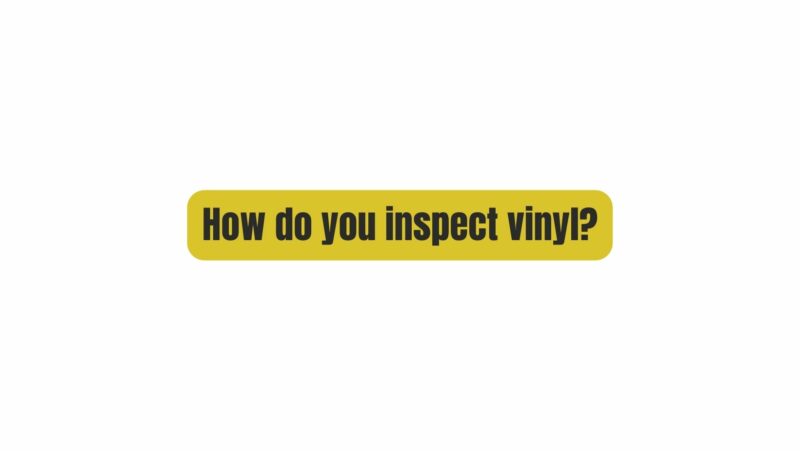Vinyl records, cherished for their analog warmth and tactile charm, continue to captivate music enthusiasts and collectors worldwide. Whether you’re a seasoned vinyl aficionado or just starting your collection, understanding how to inspect vinyl records is essential. Proper inspection ensures that the records you acquire are in good condition and capable of delivering the best possible audio experience. In this comprehensive guide, we will delve into the techniques, factors, and steps involved in inspecting vinyl records thoroughly.
Why Vinyl Inspection Matters
The process of inspecting vinyl records goes beyond mere formality; it holds substantial importance for collectors and enthusiasts:
- Condition Assessment: Inspection allows you to assess the overall condition of a record, helping you determine its value and suitability for your collection.
- Sound Quality: Properly inspected records are more likely to offer a superior listening experience, free from surface noise, skips, and other audio issues.
- Prevention of Damage: Through careful inspection, you can identify and address potential issues that could lead to record damage or deterioration.
Key Factors in Inspecting Vinyl Records
To conduct a thorough vinyl inspection, consider these key factors:
- Visual Examination: Carefully inspect the record’s surface for visible imperfections such as scratches, scuffs, and groove wear. Pay close attention to the presence of dust, dirt, or mold.
- Vinyl Condition: Assess the vinyl’s overall condition. Look for signs of warping, cracks, or signs of previous repairs. Examine the center hole for any damage.
- Vinyl Weight and Thickness: Original pressings often feature heavier, thicker vinyl. Compare the weight and thickness of the record to known originals.
- Groove Integrity: Inspect the grooves for signs of wear, especially near the lead-in and lead-out grooves. Ensure there are no deep scratches that could affect playback.
- Cleanliness: Check the record’s cleanliness. Dust and dirt can accumulate over time and impact sound quality. Ensure the record has been properly cleaned and stored.
- Vinyl Color: Some records feature unique vinyl colors or patterns, which can be part of their appeal. Verify that the vinyl color matches the expected release.
- Labels and Printing: Examine the record labels for accurate information, alignment, and printing quality. Ensure that the labels match the expected release.
- Matrix Runout: The matrix runout etched into the vinyl’s runout groove area often contains information about the record’s origin. Compare this information to known releases.
- Spindle Hole: Check the spindle hole for signs of wear or damage. A worn spindle hole can lead to instability during playback.
- Cover and Packaging: If the record is part of a set, inspect the cover and packaging for any damage, wear, or signs of water damage.
Steps in Inspecting Vinyl Records
To conduct a thorough inspection of vinyl records, follow these steps:
- Visual Examination: Hold the record under a bright light source and inspect it visually. Look for scratches, scuffs, and other imperfections on the surface.
- Cleanliness: Ensure the record is free from dust, dirt, or mold. If necessary, clean the record using a record cleaning brush or a gentle cleaning solution.
- Vinyl Condition: Check for warping, cracks, or signs of previous repairs. Run your fingers lightly over the surface to feel for any irregularities.
- Groove Inspection: Examine the grooves closely, especially near the beginning and end of each side. Look for signs of wear or damage that could affect playback.
- Label and Printing: Verify that the label information matches the expected release and that the printing quality is sharp and accurate.
- Matrix Runout: Record the information etched into the matrix runout, as this can be useful for further research and authentication.
- Spindle Hole: Inspect the spindle hole for wear or damage, which could affect how the record fits on the turntable.
- Listen: If possible, play the record to assess its sound quality. Listen for any surface noise, skips, or other audio issues.
Conclusion
Mastering the art of vinyl inspection is a skill that enhances the vinyl collecting experience. It enables collectors and enthusiasts to make informed decisions when acquiring records, ensuring that they meet their desired standards of quality and condition. Keep in mind that vinyl inspection is not merely a one-time process but an ongoing practice to preserve the integrity of your collection. With dedication and the knowledge gained from this guide, you can confidently inspect vinyl records, ensuring that each one delivers the best possible listening experience while preserving the beauty of this enduring music format.


